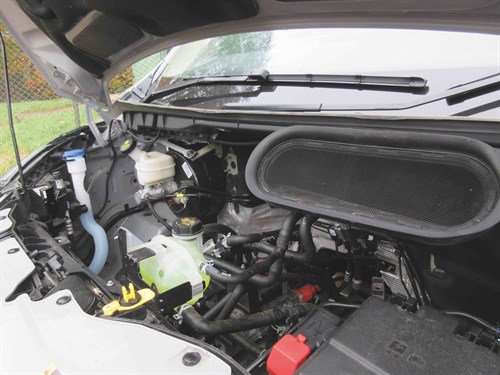- Further 4.25t electric van rule changes under consideration
- Arval research uncovers van fleet optimism
- Pre-orders open for new Nissan Interstar
- More than half of UK van drivers now believe EVs more cost effective than ICE, VW finds
- Public EV charging costs preventing adoption for some fleets, AFP says
- Ford Ranger Tremor review
- Inseego awarded Crown Commercial Service framework status
- ADVERTISEMENT FEATURE: Electrify and optimise: Digital solutions at the forefront of decarbonisation
- Fleets being pushed to take electric vans due to ZEV mandate, AFP reports
- Buying a used... Citroen Relay (2019)
The What Van? Road Test: Ford E-Transit (2022)
Date: Monday, April 3, 2023
Powertrain
E-Transit’s electric motor is fed by a lithium-ion battery pack. Ford says it delivers 68kWh of usable capacity as standard and a range of up to 197 miles between recharges according to WLTP (Worldwide Harmonised Light Vehicle Test Procedure) figures.
The charging point is at the front of the van, beneath the Ford logo.
Plug into a 7.4kW wall box and it will take 11.5 hours to recharge your van from scratch says the manufacturer. That shrinks to just over eight hours if your have access to an 11kW three-phase socket, it adds.
If you’re in a hurry however then it takes 34 minutes to charge the battery from 15% to 80% of its capacity using a 115kW DC fast-charger, says Ford.
The rotary transmission switch referred to earlier offers you the choice of Park, Reverse, Neutral and Drive. Pressing the L button in the middle of the switch gives you braking regeneration, which pumps energy which would otherwise be wasted into the battery.
Driving
E-Transit displays sure-footed handling and delivers strong acceleration all the way up to the maximum legal motorway speed, if you don’t mind depleting the battery charge. The 135kW/184hp motor packs more than sufficient punch for most applications, even if you are in the habit of running at maximum gross weight, and disgorges its power smoothly.
It does so quietly too, although this means that all the other sources of noise (tyres, suspension and so on) become a lot more obvious than they would if you were driving a diesel.
As with so many vans of its size, the ride is on the choppy side when unladen, but gets calmer and calmer the more weight you load onboard.
During our time with E-Transit we took it on a short trip in icy winter weather complete with freezing fog. Not surprisingly we had the heater turned up full blast, the heated seats on and the exterior lights blazing away.
Result?
We started our journey with a projected range of 132 miles and travelled on a round trip of just 11 miles, driving slowly and carefully because of the awful conditions. Once we got back to base, we saw that the projected range had tumbled to 107 miles rather than the 121 miles we would have expected.
The noticeable drop in the projected distance we could expect to travel between recharges might have reflected the presence of Intelligent Range on Trend models; a system which Ford says gives a highly-accurate prediction of how soon the battery will be completely depleted. It also serves to underline the inescapable fact that no matter what make and model of electric van you opt for, low temperatures will curtail your travelling distance; something to bear in mind when you are making your selection.
We were driving in Normal mode. We feared that Eco might be a no-no because of the impact it was said to have on the heater, and we had no need to select Slippery – the third choice – because there was no ice or snow on the highway.
We subsequently discovered that Eco’s effect on the heating is not as dramatic as we expected. Nor does it throttle the van’s on-highway performance unduly if you are lightly-laden, although Normal makes better sense if you’ve got a bit of weight onboard.
Regenerative braking helps preserve the range, but the system Ford has opted for is a little odd.
Using the L button referred to earlier is straightforward enough, but what you can do instead is tap the brake pedal once to get a lesser degree of regeneration. Tap it twice and you are up to L level (which isn’t especially impressive if we’re honest about it) which then turns itself off the minute you accelerate.
View The WhatVan Digital Edition



